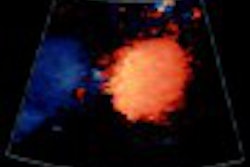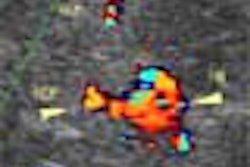Along with the valuable diagnostic information 3-D ultrasound can provide in obstetrical cases, it often yields important psychological benefits. In fact, the exam is often requested to reassure patients and physicians alike, according to Dr. Dolores Pretorius of the 3-D Ultrasound Imaging Group at the University of California, San Diego.
"When we reassure, we're not only reassuring Mom, we're also reassuring Dad, any extended family, and the physician if he's worried about something he saw or has in the family history," she said. Pretorius made her comments during a talk at the 2002 Leading Edge in Diagnostic Ultrasound conference, held in Atlantic City.
Recognizing the diagnostic value of 2-D imaging, UCSD requires a complete 2-D diagnostic ultrasound exam prior to a 3-D referral, Pretorius said. Physicians are also required to order the 3-D ultrasound.
In an early study of UCSD 3-D ultrasound referrals, the institution found that physicians initiated exams for reasons such as prior anomalies, family history of fetal anomalies, elevated AFP (alphafetoprotein), prior fetal demise, and drug exposure. For families with prior fetal anomalies, the ability to "see" a normal baby via the 3-D ultrasound can be a big relief, Pretorius said.
And for patients in whom an anomaly has been identified, the opportunity to see it for themselves can be a source of comfort.
"I had a family with an omphalocele. (The mother) felt like she could only think about that omphalocele until she saw the normal face and then she could focus on the face," Pretorius said.
Three-dimensional ultrasound studies can also help patients understand anomalies such as cleft lip or palate and anencephaly, she said. Unfortunately, sometimes the images can also generate a family bias, in which patients believe that the anomaly is not as bad as it really is.
For example, a mother carrying a baby with trisomy 13 thought the fetus' face didn’t look that bad, Pretorius said. After birth, the woman was completely shocked at the baby's appearance and didn't want anything to do with the baby, she said.
"In this case, I may have hurt her by being able to show her the pictures, because she saw what she wanted to see," she said. "It was her reality, not my reality."
Patients who said they benefited the most from 3-D ultrasound were those who had prior anomalies or fetal demise, surrogate parents, hospice patients carrying fatal anomalies, infertility cases, and family history of anomalies, she said.
Some hospice patients just wanted to see and bond with their babies in utero before they died. Another family finally accepted the reality of anencephaly based on the 3-D ultrasound images and began planning a funeral, she said. After learning that images of their fetuses would be used for education, a few hospice patients felt thankful that their fetuses would have a purpose in teaching doctors about 3-D ultrasound, she said.
Thanks to 3-D ultrasound, infertility patients were able to recognize fetal life and well-being earlier, and became extremely excited about their pregnancies, Pretorius said.
Evaluating bonding
To compare patient-fetus bonding between 2-D and 3-D ultrasound, UCSD researchers surveyed 100 normal patients, 50 of whom underwent 3-D ultrasound and 50 who had 2-D ultrasound studies.
The survey participants with 3-D studies were found to show images to twice as many people compared with 2-D exams. When asked if they could form an image of their baby, 81% said yes after 3-D ultrasound, while only 39% said yes after a 2-D study.
In another survey to test the impact of 3-D ultrasound on nonpregnant adults, UCSD researchers prepared a 15-minute audiovisual presentation showing 3-D ultrasound and 2-D ultrasound of a 30-week fetus, including a brief explanation of both technologies. The tape was then shown to 120 college students.
Of the participants, 78% said they would request a 3-D ultrasound in a future pregnancy, while 94% believed the modality was a significant diagnostic tool. Overall, 75% of women and 61% of men believed 3-D ultrasound would positively affect parental fetal attachment, Pretorius said.
Interestingly, the researchers discovered that 3-D did not impact maternal bonding. In yet another study, the researchers performed a double-blinded, randomized, controlled study of 36 primigravid pairs with an upper socioeconomic status. Participants were randomized between those who received 2-D or 3-D studies.
Videotape and one picture were given to each couple after the exam. An interview was given prior to the ultrasound study, and parents filled out questionnaires on topics related to fetal attachment and anxiety. A videotape interview was performed after birth.
Maternal-fetal bonding was found to increase throughout pregnancy, with a marked gain in bonding seen following quickening, Pretorius said. There were no significant differences in bonding between 2-D and 3-D ultrasound, regardless of gestational age at imaging, she said.
Beyond its impact on patients, 3-D ultrasound can influence physicians as well. Physicians can gain an improved understanding of anomalies, increased confidence in identifying both normal and abnormal findings, and improved assessment of symmetry, Pretorius said.
To evaluate the impact of 3-D on sonologists and sonographers, UCSD researchers surveyed 68 females and 20 males after a 45-minute lecture on 3-D ultrasound in obstetrics at a national meeting. The presentation included slides and multimedia.
Eighty percent believed 3-D ultrasound would play a role in reassurance for pregnant women, while 78% of women would like to have a 3-D ultrasound in a future pregnancy, Pretorius said. Among the men, 65% said they would encourage their partner to have a 3-D ultrasound in a future pregnancy. Fifty-four percent of those surveyed cited better visualization of normal anatomy as the reason, Pretorius said.
"After you (use) this type of technology for awhile, you get the feeling that (3-D ultrasound) really impacts some people significantly, and (for) other people, they like it but it's not that big a deal," she said.
By Erik L. Ridley
AuntMinnie.com staff writer
July 9, 2002
Related Reading
Adding 3-D to power Doppler US improves prostate cancer detection, March 25, 2002
3-D ultrasound enables precise diagnosis of PCO, March 18, 2002
Comparison between 2-D and 3-D ultrasound measurements of nuchal translucency, January 4, 2002
3-D ultrasound of fetal brain aids focused postnatal management, December 18, 2001
3-D shoulder ultrasound flexes its muscle, June 4, 2001
Copyright © 2002 AuntMinnie.com




















